The Sports Protective Equipment Market is estimated to be valued at USD 9.9 billion in 2025 and is projected to reach USD 16.6 billion by 2035, registering a compound annual growth rate (CAGR) of 5.3% over the forecast period.
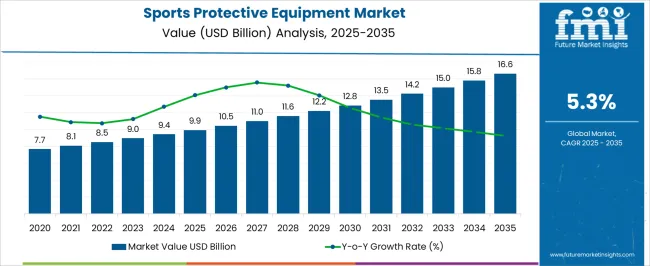
| Metric | Value |
|---|---|
| Sports Protective Equipment Market Estimated Value in (2025 E) | USD 9.9 billion |
| Sports Protective Equipment Market Forecast Value in (2035 F) | USD 16.6 billion |
| Forecast CAGR (2025 to 2035) | 5.3% |
The sports protective equipment market is witnessing consistent growth, fueled by rising awareness of sports-related injuries and an increasing emphasis on athlete safety across professional and recreational levels. Demand is being driven by stricter safety regulations introduced by sports governing bodies, alongside a growing number of participants in organized sports and fitness activities worldwide. Technological advancements in material science, such as lightweight polymers, high-impact foams, and breathable fabrics, are improving product performance, making protective gear more comfortable while maintaining high levels of safety.
The market is also being influenced by changing consumer preferences toward branded, certified, and customized products, as well as the rapid expansion of e-commerce platforms that enhance product accessibility. Sponsorships and athlete endorsements are further increasing awareness and driving consumer trust in advanced equipment.
With rising disposable incomes and greater attention to sports safety in schools, colleges, and professional leagues, the future outlook remains positive Increasing investments in product innovation and growing participation in extreme and contact sports are expected to provide strong momentum for long-term market expansion.
The sports protective equipment market is segmented by product type, area protected, sales channel, and geographic regions. By product type, sports protective equipment market is divided into Head Gear, Face Protection, Protective Pads and Guards, Gloves, and Others. In terms of area protected, sports protective equipment market is classified into Head and Face, Abdomen, Upper Extremity, and Lower Extremity. Based on sales channel, sports protective equipment market is segmented into Specialty Stores, Online Markets, and Retail stores. Regionally, the sports protective equipment industry is classified into North America, Latin America, Western Europe, Eastern Europe, Balkan & Baltic Countries, Russia & Belarus, Central Asia, East Asia, South Asia & Pacific, and the Middle East & Africa.
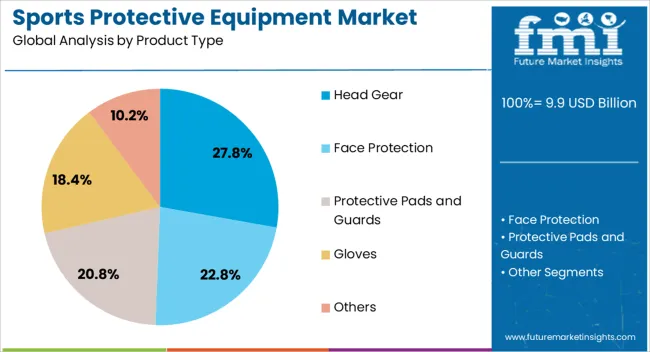
The head gear product type segment is projected to account for 27.8% of the sports protective equipment market revenue share in 2025, establishing itself as a leading category. This dominance is being supported by the growing focus on preventing head injuries, which represent one of the most critical concerns in contact and collision sports. Helmets, protective caps, and related gear are increasingly being adopted across sports such as football, hockey, cricket, and cycling, where head impacts are common.
The segment is further benefiting from ongoing innovations in design, including the use of advanced impact-resistant foams, aerodynamic shells, and integrated ventilation systems that improve both safety and comfort. Rising compliance with international safety standards has led to mandatory adoption of certified protective headgear in organized sports events, fueling demand.
Additionally, heightened awareness among parents, athletes, and coaches regarding the long-term risks of concussions and traumatic brain injuries is driving sustained adoption As sports participation continues to expand globally, the head gear segment is expected to maintain strong growth supported by technological advancements and regulatory enforcement.
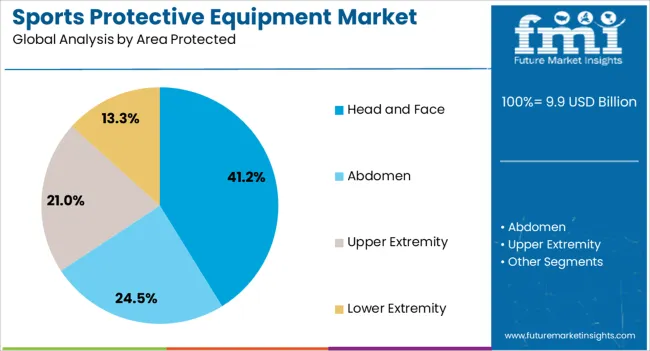
The head and face area protected segment is anticipated to hold 41.2% of the sports protective equipment market revenue share in 2025, making it the leading area of protection. This dominance is being reinforced by the high vulnerability of the head and facial region in both contact sports and high-speed activities. Injuries in this area often result in severe long-term consequences, which has created strong demand for protective products designed specifically to minimize risks.
Advanced helmets, visors, guards, and masks are being engineered with cutting-edge materials that balance strength, impact absorption, and comfort. Increasing enforcement of safety regulations by international sports associations has mandated the use of protective equipment for the head and face in both professional and youth sports. The segment’s growth is also being fueled by rising participation in adventure and extreme sports where risk factors are high.
Manufacturers are further enhancing appeal through lightweight, customizable designs and better aesthetics, making protective equipment more acceptable to athletes This combination of safety awareness, technological advancement, and regulatory support is ensuring sustained growth for this segment.
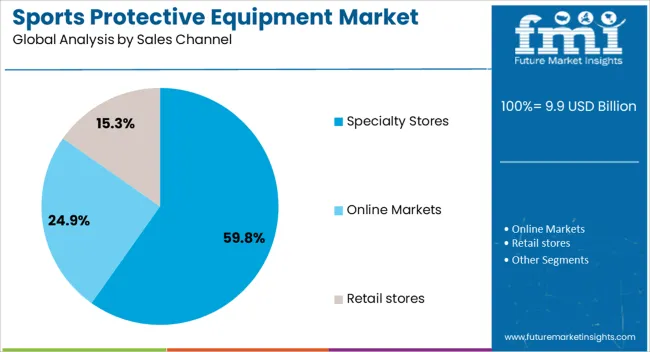
The specialty stores sales channel segment is expected to capture 59.8% of the sports protective equipment market revenue share in 2025, making it the most prominent distribution channel. This leadership is being supported by the strong consumer preference for physical retail outlets where products can be tested, fitted, and compared before purchase. Specialty stores offer a tailored shopping experience with expert advice, which is especially valuable for protective equipment where proper sizing and certification play a crucial role in safety and performance.
The ability to stock a wide variety of premium brands, coupled with opportunities for customization and after-sales services, has strengthened the appeal of this channel. Professional athletes and enthusiasts often rely on specialty stores for high-quality and certified gear, further driving segment share.
Although e-commerce is gaining traction, the tactile experience and immediate product availability offered by specialty stores remain unmatched The segment’s dominance is expected to continue as retailers invest in advanced in-store experiences, partnerships with leading sports brands, and customer-focused services that reinforce consumer trust and loyalty.
Outdoor and sports activities are trending and gaining popularity day by day due to two main reasons. The first is the post-pandemic effect. People were locked in houses for almost a year, and now are now always seeking new ways to engage themselves in outdoor activities in their free time. The second reason is increasing awareness of a healthy lifestyle. COVID made people realize that health is the biggest treasure and healthy lifestyle is what matters the most.
These reasons are increasing the engagement of people in sports activities all around the world. Schools are also including mandatory sports activities in their timetables, ultimately increasing safety equipment sales.
Safety equipment is also trending as different sports are being promoted on a national level. Different tournaments and sports events are telecasted on online platforms and Television, helping in increasing the interest of the audience in sports activities.
The rise of e-commerce is another driver for the sports protective gear market. There is a number of manufacturers producing protective gear in different forms and styles. The main sales channel for these gear was specialty stores only. But as online markets are reaching every corner of the world, anyone in need can order any equipment with ease. All these factors are having a positive impact on the Sports Protective Equipment market.
The biggest restrain on the sports protective equipment market are:
Confusion from customers; often people get confused about what equipment is necessary for them and what will be the best option. There are no advisors or guiding persons to tell what equipment should one purchase and use. This confusion often leads to miss-purchases of equipment and waste of money. To avoid such waste, people avoid purchasing and eventually just forget about them.
The second reason is the lack of distribution channels leading to other problems and delays in deliveries. There is no such proper distribution channel for sports equipment, and this leads to problems during distribution. Some equipment gets dispatched from other countries and the import and export of these goods take longer than usual. Such delays often lead to less purchases and people search for other options for purchases. Such problems are having a negative impact on the sports protective equipment market.
People in the USA are starting a healthy lifestyle during the post-pandemic times. There are lots of people starting new activities like yoga and meditation or active sports like badminton, basketball swimming, and others. Not just adults, but children are also seeing frequent sports activities in their schools. These all activities are collectively having a positive impact on sales of sports-related equipment and services.
Japanese schools are very well known for their uniqueness towards the overall development of children. There is a number of clubs related to different activities in every school. These clubs are helping children to escape from academics to develop other skills. Japanese schools are offering kendo classes, which are swordplay art. These classes require a number of equipment and safety tools, including traditional clothing, mesh helmet, shoulder pads, and gloves for practice.
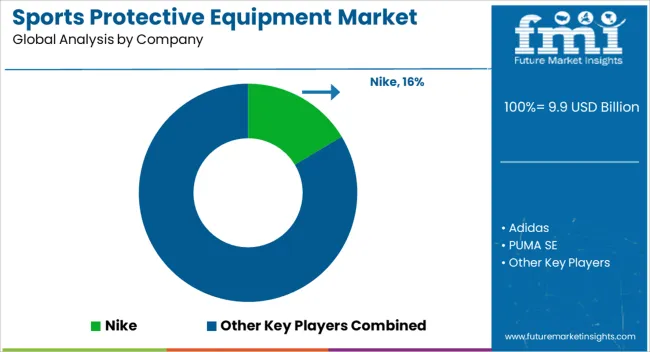
Some key players in the Sports Protective Equipment market are PUMA SE, Adidas, Amer Sports, Nike, BRG Sports, Under Armour, Riddell, Fortune Brands Inc., Dunlop Sports Group Americas Inc., Daiwa Seiko Corp., and others. These are popular and well-known brands all over the world.
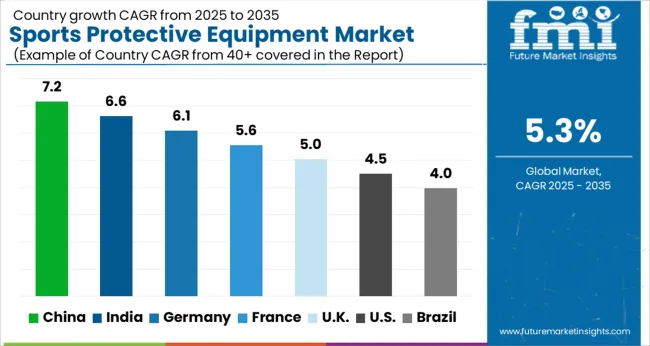
| Country | CAGR |
|---|---|
| China | 7.2% |
| India | 6.6% |
| Germany | 6.1% |
| France | 5.6% |
| UK | 5.0% |
| USA | 4.5% |
| Brazil | 4.0% |
The Sports Protective Equipment Market is expected to register a CAGR of 5.3% during the forecast period, exhibiting varied country level momentum. China leads with the highest CAGR of 7.2%, followed by India at 6.6%. Developed markets such as Germany, France, and the UK continue to expand steadily, while the USA is likely to grow at consistent rates. Brazil posts the lowest CAGR at 4.0%, yet still underscores a broadly positive trajectory for the global Sports Protective Equipment Market. In 2024, Germany held a dominant revenue in the Western Europe market and is expected to grow with a CAGR of 6.1%. The USA Sports Protective Equipment Market is estimated to be valued at USD 3.6 billion in 2025 and is anticipated to reach a valuation of USD 5.6 billion by 2035. Sales are projected to rise at a CAGR of 4.5% over the forecast period between 2025 and 2035. While Japan and South Korea markets are estimated to be valued at USD 502.0 million and USD 280.1 million respectively in 2025.
| Item | Value |
|---|---|
| Quantitative Units | USD 9.9 Billion |
| Product Type | Head Gear, Face Protection, Protective Pads and Guards, Gloves, and Others |
| Area Protected | Head and Face, Abdomen, Upper Extremity, and Lower Extremity |
| Sales Channel | Specialty Stores, Online Markets, and Retail stores |
| Regions Covered | North America, Europe, Asia-Pacific, Latin America, Middle East & Africa |
| Country Covered | United States, Canada, Germany, France, United Kingdom, China, Japan, India, Brazil, South Africa |
| Key Companies Profiled | Nike, Adidas, PUMA SE, Under Armour, Amer Sports, BRG sports, Riddell, Dunlop Sports Group Americas Inc., Fortune Brands Inc., Daiwa Seiko Corp., Jaren Corporation and others, and Others |
The global sports protective equipment market is estimated to be valued at USD 9.9 billion in 2025.
The market size for the sports protective equipment market is projected to reach USD 16.6 billion by 2035.
The sports protective equipment market is expected to grow at a 5.3% CAGR between 2025 and 2035.
The key product types in sports protective equipment market are head gear, face protection, protective pads and guards, gloves and others.
In terms of area protected, head and face segment to command 41.2% share in the sports protective equipment market in 2025.






Our Research Products

The "Full Research Suite" delivers actionable market intel, deep dives on markets or technologies, so clients act faster, cut risk, and unlock growth.

The Leaderboard benchmarks and ranks top vendors, classifying them as Established Leaders, Leading Challengers, or Disruptors & Challengers.

Locates where complements amplify value and substitutes erode it, forecasting net impact by horizon

We deliver granular, decision-grade intel: market sizing, 5-year forecasts, pricing, adoption, usage, revenue, and operational KPIs—plus competitor tracking, regulation, and value chains—across 60 countries broadly.

Spot the shifts before they hit your P&L. We track inflection points, adoption curves, pricing moves, and ecosystem plays to show where demand is heading, why it is changing, and what to do next across high-growth markets and disruptive tech

Real-time reads of user behavior. We track shifting priorities, perceptions of today’s and next-gen services, and provider experience, then pace how fast tech moves from trial to adoption, blending buyer, consumer, and channel inputs with social signals (#WhySwitch, #UX).

Partner with our analyst team to build a custom report designed around your business priorities. From analysing market trends to assessing competitors or crafting bespoke datasets, we tailor insights to your needs.
Supplier Intelligence
Discovery & Profiling
Capacity & Footprint
Performance & Risk
Compliance & Governance
Commercial Readiness
Who Supplies Whom
Scorecards & Shortlists
Playbooks & Docs
Category Intelligence
Definition & Scope
Demand & Use Cases
Cost Drivers
Market Structure
Supply Chain Map
Trade & Policy
Operating Norms
Deliverables
Buyer Intelligence
Account Basics
Spend & Scope
Procurement Model
Vendor Requirements
Terms & Policies
Entry Strategy
Pain Points & Triggers
Outputs
Pricing Analysis
Benchmarks
Trends
Should-Cost
Indexation
Landed Cost
Commercial Terms
Deliverables
Brand Analysis
Positioning & Value Prop
Share & Presence
Customer Evidence
Go-to-Market
Digital & Reputation
Compliance & Trust
KPIs & Gaps
Outputs
Full Research Suite comprises of:
Market outlook & trends analysis
Interviews & case studies
Strategic recommendations
Vendor profiles & capabilities analysis
5-year forecasts
8 regions and 60+ country-level data splits
Market segment data splits
12 months of continuous data updates
DELIVERED AS:
PDF EXCEL ONLINE
Sports Medicine Sutures Market Size and Share Forecast Outlook 2025 to 2035
Sports Betting Market Size and Share Forecast Outlook 2025 to 2035
Sports Wearables Market Size and Share Forecast Outlook 2025 to 2035
Sports Sunglasses Market Size and Share Forecast Outlook 2025 to 2035
Sports Turf Seed Market Size and Share Forecast Outlook 2025 to 2035
Sports Nutrition Ingredients Market Size and Share Forecast Outlook 2025 to 2035
Sports Food Market Size and Share Forecast Outlook 2025 to 2035
Sports Bicycles Market Size and Share Forecast Outlook 2025 to 2035
Sports Drink Industry Analysis in USA - Size and Share Forecast Outlook 2025 to 2035
Sports Officiating Technologies Market Size and Share Forecast Outlook 2025 to 2035
Sports Drug Testing Market Size and Share Forecast Outlook 2025 to 2035
Sports Streaming Platform Market Size and Share Forecast Outlook 2025 to 2035
Sports Drink Market Analysis - Size, Share, and Forecast Outlook 2025 to 2035
The Sports Medicine Market Is Segmented by Product, Application and End User from 2025 To 2035
Sports Nutrition Market Brief Outlook of Growth Drivers Impacting Consumption
Sports Analytics Market Growth - Trends & Forecast 2025 to 2035
Sports Nutrition Market Share Analysis – Trends, Growth & Forecast 2025-2035
Sports Inspired Clothing Market Analysis – Trends, Growth & Forecast 2025-2035
Sports and Athletic Insoles Market Analysis - Size, Share, and Forecast 2025 to 2035
A Detailed Global Analysis of Brand Share for Sports and Athletic Insoles Market

Thank you!
You will receive an email from our Business Development Manager. Please be sure to check your SPAM/JUNK folder too.
Chat With
MaRIA